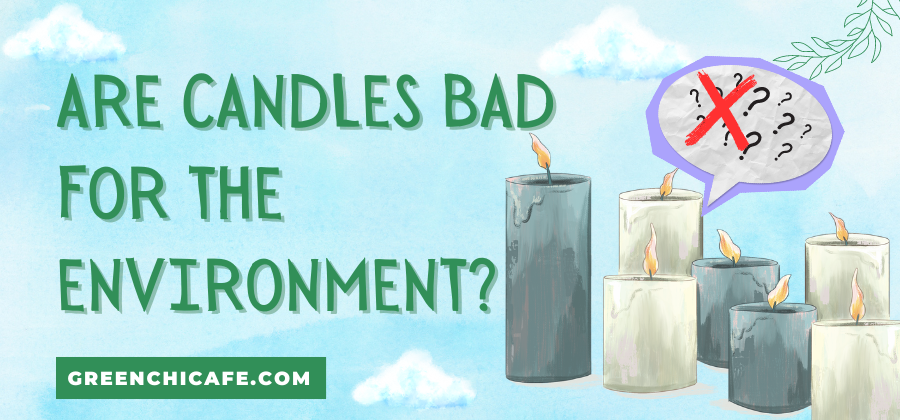While an enjoyable household item, certain candles pose ecological risks from their materials and production.
Conventional paraffin candles derive from petroleum, emitting pollutants that threaten ecosystems and health.
But beeswax, soy, and other alternative candles avoid these consequences through renewable, nontoxic ingredients.
Are Candles Bad for the Environment?

Conventional paraffin candles have negative environmental impacts from petroleum extraction, emissions when burned, and non-biodegradability.
However, natural soy, beeswax, and other vegetable-based candles with cotton wicks provide sustainable aroma and ambiance without harming ecosystems or health.
Key Points
- Paraffin wax derives from nonrenewable crude oil through polluting processes.
- Toxins and soot released by burning paraffin pose ecological and health risks.
- Beeswax and soy candles utilize renewable, biodegradable materials.
How Does Paraffin Wax Impact the Environment?
Paraffin wax comes from nonrenewable crude oil.
Extraction and refining processes pollute the air and water with harmful emissions.
Burning paraffin candles then release these toxic chemicals into homes.
The black soot produced by paraffin candles also contains carcinogenic hydrocarbons.
Overall, paraffin poses risks at every stage from extraction through lighting, making it an unsustainable choice.
Do Scented Candles Worsen Impacts?
Yes, scented candles infused with synthetic fragrances and dyes magnify the health and ecological hazards of paraffin wax.
Phthalates and other noxious chemicals in scented candles become airborne when burned.
These added compounds increase toxin exposure and plastic waste from decorative candle jars.
Opting for unscented or naturally scented soy alternatives minimizes harm to people and the environment.
Why are Beeswax Candles Considered More Sustainable?

Beeswax is a renewable, biodegradable material made by honeybees.
Harvesting beeswax sustainably from hive frames or cappings does not harm the bees.
Gentle processing retains its nontoxic purity.
Burning beeswax candles releases only water vapor and minimal natural carbon dioxide.
Beeswax candles are also reusable through techniques like candle recycling. Overall, beeswax offers a low-impact alternative.
Do Soy Wax Candles Have Environmental Benefits?
Soy wax comes from a renewable plant-based resource.
It is biodegradable, non-toxic, and free of chemicals.
Soy candle production emits less CO2 than paraffin counterparts.
However, some commercial soy candles still contain preservatives and synthetic scents.
Opting for 100% soy wax and essential oil scents maximizes environmental and wellness advantages over paraffin.
How Does Candle Wick Type Influence Emissions?
Traditional wicks contain toxic metals like lead and zinc that release dangerous fumes when burned.
Cotton and paper fiber wicks avoid metal cores linked to air pollution.
However, plant-based wicks may require trimming to prevent smoking.
Beeswax candles often have braided cotton wicks that curl over as they burn, avoiding emissions.
Wick choices significantly impact candle sustainability.
What Are Candle Recycling Options?
Spent candle wax can be recycled into new candles by remelting and adding fresh wicks.
Paraffin can be filtered through coffee filters to remove soot and combined with beeswax.
Trimmed wicks, repurposed jars/tins, and reused candle wax minimize waste through recycling.
Some companies also upcycle used wax into new candles, further closing the loop.
Reusing and upcycling extend the lifecycle of candle materials.
How Do You Responsibly Dispose of Candles?
Allow the melted wax to fully harden before discarding to minimize fuel content. Recycle glass jars, metal tins, and wicks when possible.
Ensure wicks are extinguished before trashing.
Never burn or dispose of candle wax down drains as chemicals persist.
Combine hardened wax remnants to maximize recycling yields.
Responsible disposal and upcycling reduce candles’ environmental footprint.
Are Candles Really Bad for the Environment?
Yes, conventional paraffin candles are detrimental to the environment because paraffin is a petroleum product requiring extraction and refining processes that pollute air and water.
Burning paraffin candles releases additional toxins into the atmosphere.
The soot also contains carcinogenic particles.
However, natural soy, beeswax, and plant-based candles avoid these issues through renewable, biodegradable ingredients that produce minimal emissions when burned.
So while paraffin poses risks, sustainable candle options allow enjoying ambient lighting without ecological consequences.
Are Candles More Environmentally Friendly Than Lights?
When made from natural waxes and lead-free wicks, candles can be more eco-friendly illumination than electric lights that rely on power plants, often fueled by coal or natural gas.
Beeswax and soy candles use renewable resources and burn clean.
However, new LED lightbulbs use a fraction of the energy of traditional incandescent bulbs to provide brighter, longer-lasting light with minimal emissions.
So LED lights may be comparable or superior to natural-wax candles in environmental friendliness.
Why are Candles Toxic to the Environment?
The primary toxins come from paraffin wax, a petroleum product.
The extraction of crude oil, as well as the refining process, releases harmful pollutants.
Lead-core wicks also disperse heavy metal particulate emissions when burned.
Even dyes and synthetic scents emit volatile organic compounds.
When burned, paraffin candles release these toxins into the surrounding environment.
The soot also contains carcinogens.
Overall, conventional candle ingredients and emissions contaminate ecosystems and reduce air quality both indoors and out.
Is Burning Candles in the House Bad?
Burning paraffin or other petroleum-based candles inside poses health and environmental risks from inhalation of toxic benzene, toluene, and other airborne compounds.
Lead-wicked candles also release heavy metal particulate emissions indoors.
However, natural soy, vegetable, or beeswax candles with cotton wicks provide a nontoxic indoor ambiance.
Using candles moderately, with ventilation, also reduces exposure.
Proper candle choice minimizes risks.
In Summary
While paraffin wax poses risks, sustainable natural waxes, lead-free wicks, and recycling enable eco-friendly illumination. With informed purchasing and proper disposal, candles can provide ambiance while also honoring our interconnected welfare and ecosystems.
FAQ
Why are Beeswax Candles Environmentally Friendly?
Beeswax comes from a renewable hive product collected without harming bees. Gentle processing retains its nontoxic purity. Burning beeswax produces minimal emissions. The wax and cotton wicks biodegrade safely.
How Does Candle Wax Get Recycled?
Used candle wax can be filtered, remelted, and combined with new wax. Trimming wicks enables reuse. Some companies upcycle spent wax into new candles, closing the production loop.
What Types of Wicks are Most Sustainable?
Unbleached natural fiber wicks like organic cotton minimize air pollution and health risks. Some beeswax candles have braided cotton wicks that self-extinguish through curling as they burn.
How Do You Dispose of Candle Jars and Tins?
Glass jars, repurposed tins, and metal containers should be recycled whenever possible. Separating remaining wax residues enables proper recycling. Reusing containers for storage or crafts is also beneficial.
At GreenChiCafe, we are passionate about protecting the natural world and sharing knowledge that cultivates more sustainable lifestyles.
Please check out our website for more content about caring for our planet and living eco-consciously.
